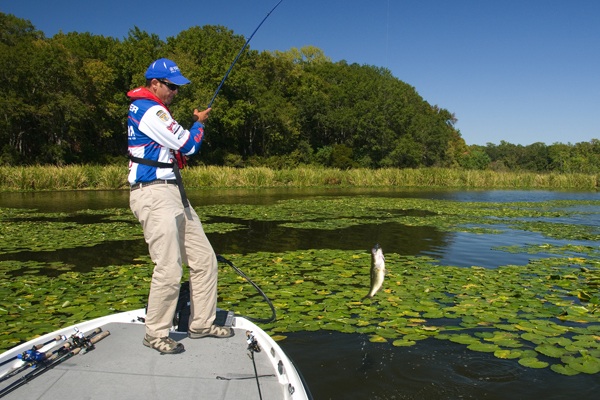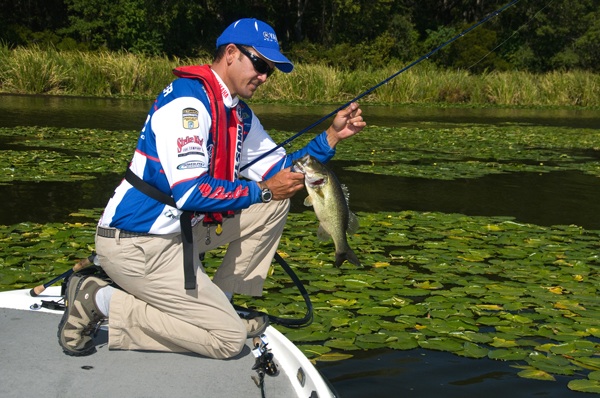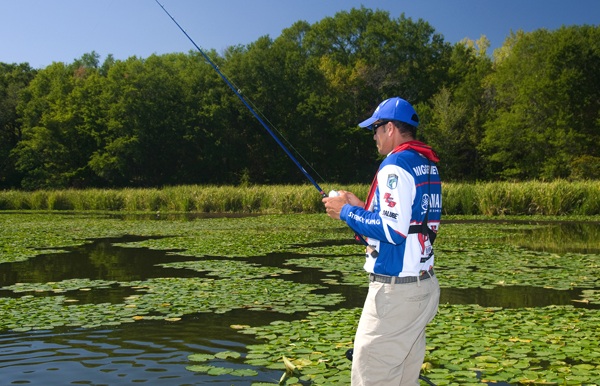Lily Pads Can Provide Excellent Autumn Action
Category: npaa
Oct 26th, 2011 by OutdoorsFIRST
Modified Oct 26th, 2011 at 12:00 AM
Lily pads are generally included on any angler’s must-fish list, but during the autumn months they’re always at the very top of tournament veteran James Niggemeyer’s list. The Yamaha Pro likes to start his day casting to the familiar green floating plants, and it normally doesn’t take many casts before he finds bass, either.
 |
|
|
|
“Lily pads provide both vertical and horizontal cover as well as shade in shallow water,” he explains, “and bass everywhere are moving shallow in September and October so they’re naturally attracted to them. Except in extremely clear water, lily pads don’t grow deeper than about five feet, which makes them easy and fun to fish, too.
“A field of pads, especially an irregular one that features a lot of pockets, points, and open channels can actually map the bottom structure for you, since each edge where the pads stop growing usually indicates either a change in water depth or bottom composition. These are the very same features that attract bass and baitfish. When you add additional cover like fallen trees, pier pilings, or milfoil and hydrilla, the pad field becomes even more attractive.”
Niggemeyer prefers to start fishing around these types of irregular features, and his favorite autumn lure is a ½-ounce jig with a crawfish-type trailer. He may alternate the jig with a plastic tube or a topwater frog, depending on where the bass are located and how they’re acting. He uses 56-pound braided line, and a heavy action, 7-foot, 11-inch rod.
“I really like to use a jig because its bulky profile effectively imitates larger forage that hopefully will attract a bigger bass,” notes the Yamaha Pro. “A jig also produces better results when the bite is really tough, or if the bass are slightly deeper, closer to the bottom. When bass are really aggressive and holding just below the surface, I like to use a frog because I can cover more water, but overall, a jig will draw strikes regardless of where the bass are located.
Jigs are well-known as big-bass lures, and lily pad fields seem to attract plenty of quality fish because food and cover is so abundant. Niggemeyer has not caught any 10-pound largemouths in lily pads, but he’s caught plenty of fish in the five to eight-pound range in pads, both during tournament competition as well as while guiding at Lake Fork in Texas.
“Most strikes come as the jig is falling, and often you’ll never even feel it,” he explains. “The bass are actually suspended somewhere underneath the floating pads, and all you’ll see will be a slight twitch in your line. Then the line usually starts moving away and you’d better set the hook. I always use braided line when I’m fishing like this, because the line has no stretch and actually slices through the pads and stems as the bass jumps and thrashes. I need the heavy action rod to control the fish in that type of cover.”
 |
|
|
|
If his jig reaches the bottom without being hit, Niggemeyer likes to hop it slightly once or twice, or slowly yo-yo the lure up and down a few moments. If he has been getting strikes as the jig is falling, he tries to create as many falls as possible.
“I may swim the jig occasionally, too,” he continues, “especially when I’m still trying to determine the presentation bass want that day. Most of my casts are really just short pitches, and I work both the edges of the pad field as well as the thickest areas I can see until I learn where the fish are.
“Even though the lily pads are the most obvious visible cover on the surface, I have seen numerous instances where bass seemed to prefer some other cover within the pad field, such as grass or weeds, and I’ve experienced days when the bass weren’t actually in the pads at all, but instead, holding along an edge.
“This is why I really like to start fishing lily pads where the field is more irregular and broken, rather than stretching unbroken for several hundred yards or more,” concludes the Yamaha Pro. “The majority of the time, bass will be located in or close to some irregular feature you can easily see.”
 |
|
|
|